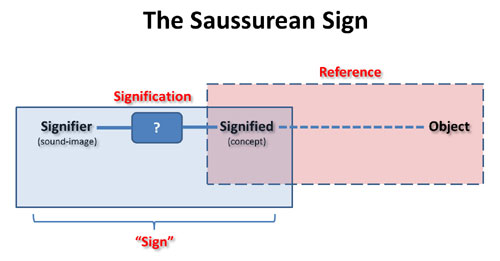-
If you are citizen of an European Union member nation, you may not use this service unless you are at least 16 years old.
-
You already know Dokkio is an AI-powered assistant to organize & manage your digital files & messages. Very soon, Dokkio will support Outlook as well as One Drive. Check it out today!
| |
Class 13 Notes
Page history
last edited
by Alan Liu 10 years, 2 months ago
Preliminary Class Business
Charles Bernstein, "You" (1983)
L=A=N=G=U=A=G=E Poets
- Charles Bernstein
- Bob Perelman
- Ron Silliman
- Susan Howe, Bruce Andrews
- Lyn Hejinian
- Barrett Watten
- etc.
From last class

Deconstruction
1. Jacques Derrida (1930-2004)
Derrida's (Un)Thought
Sentences from Derrida
(PDF version)
- From "Structure, Sign, and Play":
From the basis of what we therefore call the center (and which, because it can be either inside or outside, is as readily called the origin as the end, as readily arché as telos), the repetitions, the substitutions, the transformations, and the permutations are always taken from a history of meaning [sens]-that is, a history, period-whose origin may always be revealed or whose end may always be anticipated in the form of presence.
- From "Structure, Sign, and Play":
This field is in fact that of freeplay, that is to say, a field of infinite substitutions in the closure of a finite ensemble. This field permits these infinite substitutions only because it is finite, that is to say, because instead of being an inexhaustible field, as in the classical hypothesis, instead of being too large, there is something missing from it: a center which arrests and founds the freeplay of substitutions.
- From Of Grammatology (pp. 19-20):
Now in this direction (but only in this direction, for read otherwise, the Nietzschean demolition remains dogmatic and, like all reversals, a captive of that metaphysical edifice which it professes to over-throw. On that point and in that order of reading, the conclusions of Heidegger and Fink are irrefutable), Heideggerian thought would reinstate rather than destroy the instance of the logos and of the truth of being as “primum signatum:” the “transcendental” signified (“transcendental” in a certain sense, as in the Middle Ages the transcendental—ens, unum, verum, bonum—was said to be the “primum cognitum”) implied by all categories or all determined significations, by all lexicons and all syntax, and therefore by all linguistic signifiers, though not to be identified simply with any one of those signifiers, allowing itself to be precomprehended through each of them, remaining irreducible to all the epochal determinations that it nonetheless makes possible, thus opening the history of the logos, yet itself being only through the logos; that is, being nothing before the logos and outside of it.

A. Critique of the Sign
- From Positions (1972), pp. 19-20:
- "The maintenance of the rigorous distinction--an essential and juridical distinction--between the signans and the signatum, the equation of the signatum and the concept, inherently leaves open the possibility of thinking a concept signified in and of itself, a concept simply present for thought, independent of a relationship to language, that is of a relationship to a system of signifiers. By leaving open this possibility--and it is inherent even in the opposition signifier/signified, that is in the sign--Saussure contradicts the critical acquisitions of which we were just speaking. He accedes to the classical exigency of what I have proposed to call a 'transcendental signified,' which in and of itself, in its essence, would refer to no signifier, would exceed the chain of signs, and would no longer function as a signifier. On the contrary, though, from the moment that one questions the possibility of such a transcendental signified, and that one recognizes that every signified is also in the position of a signifier, the distinction between signified and signifier becomes problematical at its root."

- Some important terms used by Derrida and deconstruction:
- "Center" / "Decentered"
- "Presence" / "Absence"
- "Trace"
- "Différance"
- "Différance"
- "Catachresis"
- "mise en abyme"
- "Intertextuality"
Class 13 Notes
|
|
Tip: To turn text into a link, highlight the text, then click on a page or file from the list above.
|
|
|
|
|
Comments (0)
You don't have permission to comment on this page.